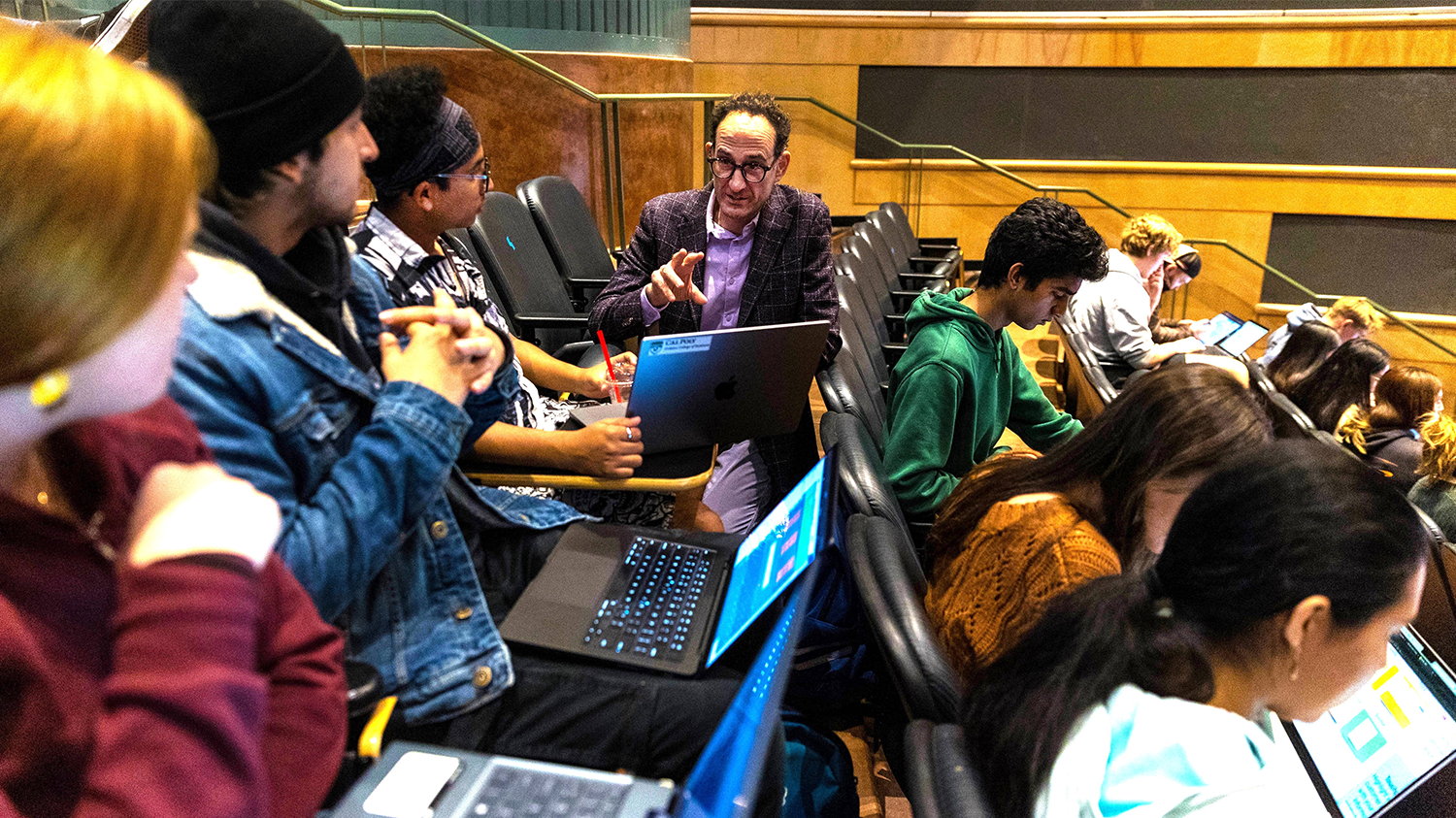Marketing Impact: Class Connects Projects to U.N. Sustainable Development Goals

Stern Neill, center, speaks with some of the students in his Principles of Marketing class. (Photo/Pat Pemberton)
For his final project in Principles of Marketing, Angel Losoya and his team of five proposed a solution to the problem of education inequality: providing microgrants to teachers in underserved regions.
But such a proposal would need to be effectively marketed toward educators to encourage applicants.
“For marketing, you really had to outreach and connect with your consumers, so that is what we tried to do with the project – really make it really personal to the consumers or make it as relatable as we could,” Losoya said.
Coming from a “not so educated background,” Losoya said he believes everyone deserves an opportunity to see their potential in education. Losoya lived in Mexico briefly, Long Beach County, and finally moved to San Bernardino before college.
“I came from a very low-income background growing up, and a lot of my friends did not even consider school as an option for the future,” Losoya said. “I just wanted to come up with an idea so schools in my area can at least have the opportunity to display what college life and higher education could look like.”
In the class, marketing professor Stern Neill leads 27 student teams through a 10-week project applying marketing principles to real-world challenges tied to the United Nations’ Sustainable Development Goals (SDGs). Losoya’s team focused on educators, crafting a strategy to engage and support teachers in underserved regions.
Teams then had to come up with a solution to address the issue in the U.N.’s Sustainable Development Goals.
Over 10 weeks, teams conduct research, define customer personas, develop marketing strategies, and present final recommendations, mirroring the real-world marketing planning process.
The SDG Goals are goals that are an “urgent call for action by all countries – developed and developing – in a global partnership,” according to the U.N.’s website.
In using the SDG goals, Neill said he wanted to connect classroom learning with real-world challenges.
Photo gallery: Stern Neill’s class works on their projects. (Photos/Pat Pemberton)
“The idea is that students can see how these marketing principles can be used not just for profit, but also for addressing societal issues,” Neill said. “Students apply market research, customer analysis, and value proposition development to shape their solutions, gaining hands-on experience in strategic marketing.”
Neill said through background research, the students dive into what their customer has experienced. From there, they communicate with the ‘clients’ to determine needs and solutions.
Throughout his team’s research about quality education, Losoya said they learned about how some schools get a surplus of funding while others lack resources based on the area they live in.
“I can relate a lot to not always receiving a quality education, just because of my demographic, or the area I grew up in,” Losoya said. “So I wanted to do a project that focused on being more accessible to pursue a quality education, and the main problem is always usually trying to persuade a group of people that an education is a necessity, and it’s also a lack of funding that really takes students out of getting a quality education.”
Neill has four mentors in the class that work with students on their projects to ensure their success. Isabella Vaka decided to be a mentor because she enjoyed her own experience in Principles of Marketing with a different professor.
“I was recommended by my finance professor to this opportunity, and I thought it would be a great way to both strengthen my leadership skills and give back to new students,” Vaka said. “I think that mentorships are extremely valuable to the growth and success of both mentors and mentees.”
Sabrina Ahrendt, a mentor in the class, talked about some of the challenges. Ahrendt likes being a mentor because she works through problems that arise during the students’ projects and gains knowledge herself.
“The format of the class is brand new this quarter, meaning the professor has not taught this course to 130 students in the business silo,” Ahrendt said. “It has always been more of a smaller class size with about 60 students, so the entire format and materials were changed this quarter.”
Neill acknowledged the shift to a larger class size brought new challenges but emphasized the opportunity it provided. “Scaling up the course challenged students to collaborate effectively, fostering diverse perspectives and team-based problem-solving,” he said.
Neill said he hopes this structure works and that the students learn, describing the class as “experimental” and “innovative.” Neill said he is launching this method of teaching while he is developing it, using the experience to constantly improve the structure.
“I think all of them professionally are going to be in situations where they’re dealing with externalities,” Neill said. “And even as individuals, they have to think about, what’s my brand? How am I positioning myself? What is the unique value that I offer? How do I communicate that? How do I deliver that? It’s just all these principles, basic principles of marketing, I think that are so applicable in so many situations that I hope students gain from that. And that this project is one way to make that happen.”
Coming into the class, Losoya did not have too much of an idea what marketing was, just that it was the promotion of products.
“From the first day, he really showed it’s more than just promotion,” Losoya said. “There are a lot of different aspects, roles, and jobs for marketing, so it just really expanded on the topic that I vaguely knew and even explored more career options with this degree.”
Neill added, “The project not only broadened students’ understanding of marketing but also showed them how strategic thinking can drive meaningful change—skills they’ll carry into their future careers.”
Your support for marketing classes like this can help students have a positive impact on their communities.












